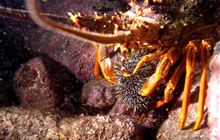Consultation on marine protection in the Hauraki Gulf/Tīkapa Moana
Introduction
Consultation on the proposed protection areas closed at 5 pm on 28 October 2022.We sought feedback on marine protection areas which aim to revitalise the Hauraki Gulf/Tīkapa Moana. This included 19 new protection areas and the use of two new marine protection tools. These tools will be established through new legislation.
The legislation, The Hauraki Gulf/Tīkapa Moana Marine Protection Bill, will increase the area under protection in the Gulf from just over 6% to about 18%. This increase will support the recovery of some of its most biodiverse regions.
Read Revitalising the Gulf Marine protection proposals document (PDF, 1,286 K)
These protection areas were first announced in the strategy ‘Revitalising the Gulf: Government action on the Sea Change Plan’ in 2021. They were refined after engagement with mana whenua, stakeholders and the public in the Gulf.
The protection was proposed by the Minister of Conservation and the Minister for Oceans and Fisheries.
Feedback summary
The Department of Conservation received support for these protection measures and for the overall aim of Revitalising the Gulf. The feedback reiterated how crucial the health of the Hauraki Gulf is for a wide range of people.
We received feedback from 13 mana whenua groups, over 15 industry representatives and commercial fishers, and 7,550 email submissions. Feedback was also received from councils, researchers, community groups, conservation groups and the general public.
Most of the email submissions were form submissions which were organised by four groups:
- LegaSea
- Forest and Bird
- Revive our Gulf
- Gulf Users Group.
All individual or group submissions, which are not form submissions are under ‘Unique Submissions’.
Submissions received
- LegaSea submissions Part 1 (PDF, 25,277K) Note: this is a large file
- LegaSea submissions Part 2 (PDF, 19,304K)
- LegaSea submissions Part 3 (PDF, 25,158K) Note: this is a large file
- LegaSea submissions Part 4 (PDF, 2,864K)
- Forest and Bird submissions (PDF, 12,770K)
- Gulf User Group submissions Part 1 (PDF, 10,690K)
- Gulf User Group submissions Part 2 (PDF, 5,451)
- Revive our Gulf submissions (PDF, 4,975K)
- Unique submissions Part 1 (PDF, 11,450K)
- Unique submissions Part 2 (PDF, 10,230K)
- Unique submissions Part 3 (PDF, 10,716K)
- Unique submissions Part 4 (PDF, 24,459K) Note: this is a large file
- Unique submissions Part 5 (PDF 18,616K)
- Unique submissions Part 6 (PDF, 7,460K)
- Unique submissions Part 7 (PDF, 9,474K)
- Unique submissions Part 8 (PDF, 10,022K)
- Unique submissions Part 9 (PDF, 17,782K)
- Unique submissions Part 10 (PDF, 12,367K)
Redactions of contact details, and other information, have been made in accordance with the Official Information Act 1982.
What was consulted on?
The marine protection proposals included:
2 protection areas: These will be adjacent to Te Whanganui-o-Hei / Cathedral Cove Marine Reserve and Cape Rodney – Okakari Point (Goat Island) marine reserves. Following consultation, these will be protected as marine reserves, effectively extending the two existing marine reserves.
12 high protection areas (HPAs): These will protect and enhance marine communities, ecosystems, and habitats. HPAs will provide for the expression of customary practices by mana whenua. This means customary practices can continue in HPAs, through existing regulatory arrangements, in a way that is consistent with the area’s biodiversity objectives.
5 seafloor protection areas: These areas will protect sensitive sea floor habitats. They will do this by prohibiting activities that damage or disturb the seafloor, like bottom trawling and mining. But they will still allow for activities that do not conflict with seafloor protection objectives. Such as fishing that does not use bottom-contact methods, snorkelling, and kayaking.
More information on pages 60 - 61 of Revitalising the Gulf (PDF, 4,798K).
Explore our pages Revitalising the Gulf: Government action to restore the Hauraki Gulf/Tīkapa Moana
Potential economic impact on fishers
We commissioned an economic impact assessment (EIA) of the Revitalising the Gulf marine protection proposals. This assessment was completed in two stages:
Stage 1: Commercial fishing report
We assessed current commercial fishing activity within the proposed protection areas to determine the potential impact of the proposals on commercial fishers.
Read the Stage 1 commercial fishing report (PDF 1,246K)
What the report showed
The assessment shows that a small number of commercial fishers (less than 10) did more than 15% of their fishing within the proposed protection areas in 2019/20 and 2020/21.
A few of those fished within the proposed protection areas in only one of the two years. We know that fishing patterns and effort can be highly variable between years, and this is reflected in the assessment.
Stage 2: Recreational fishing and wellbeing report
We reviewed the impact of the marine protection proposals on recreational fishers, the macroeconomic impacts from Stage 1, and a wider wellbeing perspective using the Treasury’s Living Standards Framework.
Read the Stage 2 recreational fishers and wellbeing report (PDF, 1,786K)
What the report showed
The report showed that a small proportion of recreational fishing (9.6%) occurred in areas designed to be high protection areas based on data from the 2017/18 fishing year.
It also showed the proposals vary in how they will affect the economy and aspects of national wealth.
An example of this would be that the ability of commercial fishers to transfer their fishing effort to other areas will vary. It could depend on factors like personal and financial circumstances, other government policy interventions, and ongoing fisheries management decisions.
Limitations of the reports
Some parts of both reports have been redacted due to the presence of fine scale information that may be commercially sensitive.
For more information on caveats and limitations see:
- Stage 1 report: page 6 of the report document (PDF 1,246K)
- Stage 2 report: referenced throughout the report (PDF, 1,786K)
Next steps
The Regulatory Impact Statement has been made available.
Regulatory Impact Statement (PDF, 5,917K)
The Minister for Oceans and Fisheries and the Minister of Conservation are responsible for progressing the proposals in the form of a Bill.
The Bill will create the tools needed (high protection areas and seafloor protection areas) to provide protections.
There will be a further opportunity for the public to provide feedback on the Bill during the Select Committee process.
Contact
If you have any questions, email us at seachange@doc.govt.nz



